
VR Training Programs: Examples, Benefits, Success Stories
VR Training Programs: Examples, Benefits, and Success Stories
What if training wasn’t limited by location, time, or physical risks? That’s what VR training programs promise—a limitless learning environment where employees can practice anything, anywhere.
With the help of VR, new hires can perfect their skills in realistic scenarios without disrupting operations or risky consequences.
In this guide, we will discuss VR training programs, their benefits, costs, and more. We will also share some guidelines on choosing one that fits your organizational needs.
What Is a VR Training Program?
A VR training program uses virtual reality technology to simulate real-world learning and skill development scenarios. Participants engage in immersive, interactive environments that replicate tasks, procedures, or experiences. VR training programs enable hands-on practice without real-world risks.
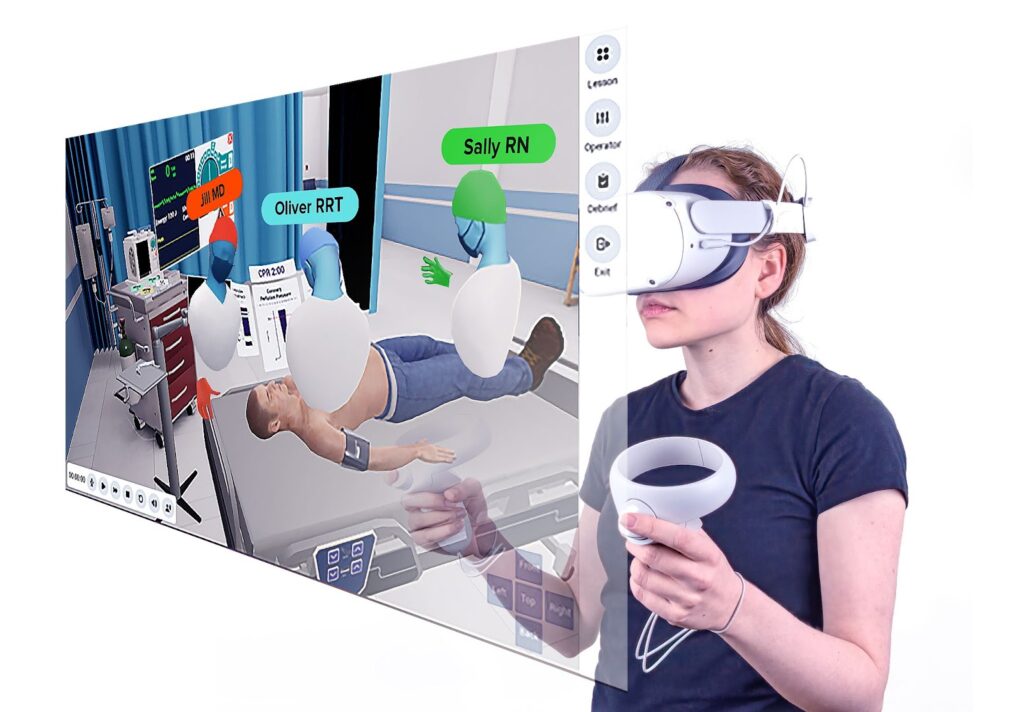
Virtual reality training typically includes:
- Customizable + pre-built training modules.
- Interactive 3D simulations that mimic real-world challenges.
- Hardware such as VR headsets, controllers, and motion sensors.
- Analytics to track progress and performance.
Studies show that employees can be trained up to four times faster in VR courses compared to traditional classroom settings.
VR Training vs. Traditional Training
Traditional training includes in-person sessions and classroom learning. In conventional training, learners engage with instructors in physical environments. While effective in some cases, it often struggles with realism, cost, and scalability.
Traditional training is often:
- Unrealistic due to high-risk scenarios.
- Expensive or logistically difficult to replicate.
- Inconsistent across different teams and locations.
VR training solves this by being:
- Immersive (putting learners in lifelike settings).
- Safe (eliminating risks associated with physical training environments)
- Scalable (allowing businesses to train employees anywhere, anytime)
Benefits of VR Training Programs
Deloitte estimates that by 2025, about 70 percent of employee training will incorporate VR in some way.
Safe Simulation of High-Risk Scenarios
Traditional training for high-risk tasks often comes with significant dangers for both trainees and the individuals or systems involved.
In healthcare, this risk is particularly critical. In real-world training, trainees might make medical errors that could harm patients. While they face the stress and potential harm of working in high-pressure environments.
VR training programs eliminate these risks by simulating high-risk scenarios in a controlled environment. A great example is Lumeto, a VR medical training platform designed to provide lifelike simulations for the healthcare industry.
The video below is an example from Lumeto’s VR training library. It shows how medical trainees can interact with tools that mirror real-world conditions.
In this specific example, a trainee is guided through the process of preparing and administering medication in a virtual clinical environment. The simulation includes realistic equipment like syringes, medication vials, and a medical cart, all clearly labelled for instructional purposes.
Increased Engagement
VR training has been shown to enhance learner engagement. Unlike traditional methods, VR allows participants to interact with realistic scenarios, which makes training sessions more immersive and memorable. Studies reveal that learners tend to:
- Grasp concepts more quickly.
- Retain knowledge for longer periods.
- Build confidence in applying skills in real-world settings.
The infographic showcases key findings from a study conducted by The American College of Chest Physicians (CHEST) using Lumeto’s VR training solutions.
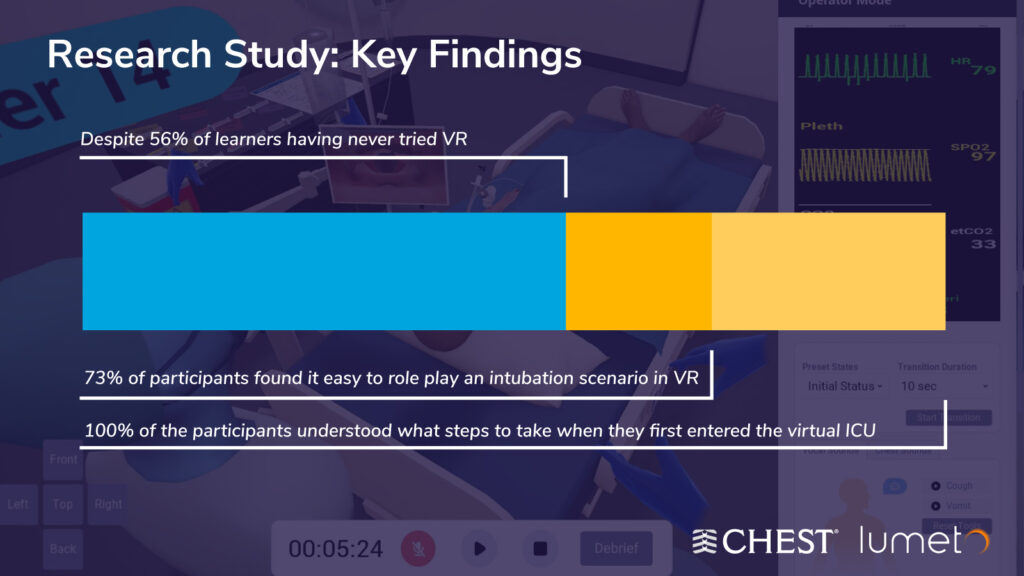
Despite 56% of participants having no prior VR training program experience, 73% found it easy to role-play an intubation scenario in a virtual ICU.
100% of participants understood the steps to take when entering the virtual environment. It shows how intuitive and impactful VR training can be for complex medical procedures.
Scalability (and Consistency)
Traditional employee training works well for small groups, such as the typical classroom size. But as the number of participants increases, consistent training and cost-effectiveness becomes challenging.
In fields like healthcare, inconsistency in medical training can be bad for patients and healthcare professionals. VR training addresses this issue and makes training consistent for all trainees.
Take police mental health training as an example. In Ontario, around 1,000 public safety officers across 13 police services were trained in mental health crisis response. They were taught de-escalation techniques using one of Lumeto’s VR training programs. The program gave every officer the same high-quality training experience, regardless of location or schedule.
The same consistent training quality could not have been achieved with in-person training alone.
Improved Spatial Awareness
Spatial awareness refers to the ability to understand and navigate the physical space around you. It includes recognizing the position and movement of objects in relation to yourself and other objects.
Psychologically, it involves processing sensory input—visual, auditory, and tactile—to create a mental map of your surroundings.
VR training enhances spatial awareness by immersing users in 3D environments that mimic real-world scenarios. Unlike traditional training methods, VR training programs require trainees to move, interact, and react as they would in actual spaces. For example:
- VR engages hand-eye coordination through realistic interactions.
- Virtual environments allow users to practice judging distances, heights, and angles.
- VR scenarios often simulate complex environments where multitasking is necessary.
Here’s a video of medical professionals being trained through Lumeto’s VR platform:
Real-Time Feedback and Assessment
One of the most powerful features of VR training is the ability to provide real-time feedback and performance assessment. Trainers can monitor a trainee’s actions and deliver immediate corrections.
Self-directed learning (SDL) modules benefit from integrated assessment tools, offering trainers an overview of each trainee performance metrics.
The snapshot below of Lumeto’s online platform showcases how trainers can evaluate specific skills being taught in each training session. The portal provides a breakdown of top and bottom skills, enabling targeted feedback and tailored improvements.
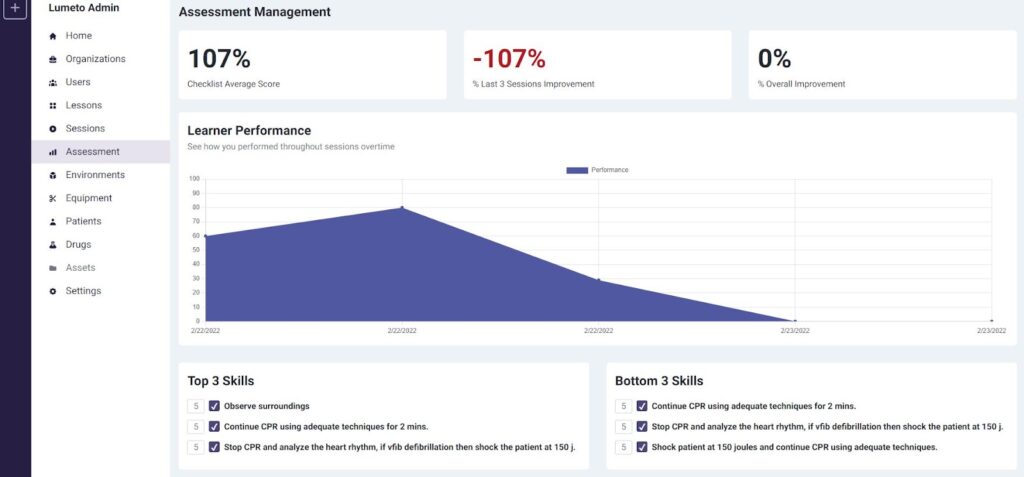
VR Training Examples in Different Industries
Let’s explore how VR impacts differentsectors, starting with one of the most critical: healthcare.
Healthcare
The healthcare industry urgently needs VR training. It directly tackles the risks of medical errors, which are the third leading cause of death in the US.
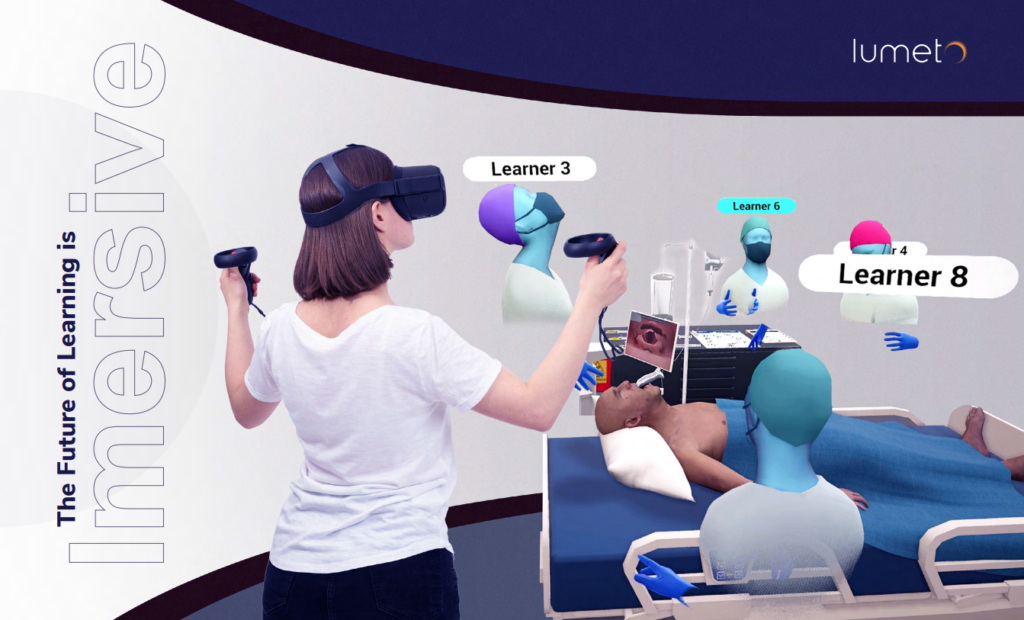
TMU alumni Halyna Yurkiv, in collaboration with Lumeto, developed a VR program for nursing students. The program trains them to manage respiratory distress emergencies. Using a VR headset, nursing students respond to alarms, monitor vitals, and choose the tools to stabilize virtual patients.
A pilot study revealed significant improvements in knowledge scores. Students also reported high satisfaction with the VR training experience.
Military
The military has adopted VR training to prepare personnel for critical safety and emergency response scenarios. It allows soldiers to practice lifesaving skills (providing medical aid or responding to natural disasters). VR also enables realistic training for rescue and recovery missions.
Manufacturing
In manufacturing, health, safety, and environmental concerns are paramount. VR training helps workers develop essential skills while minimizing risks in potentially hazardous environments.
Instead of learning on the job with heavy machinery or dangerous tools, employees can practice safely in a virtual setting.
HVAC
The HVAC industry faces significant health and safety challenges during training. VR offers a risk-free environment where technicians can practice handling complex systems and hazardous scenarios.
For example, technicians can learn to diagnose and repair HVAC units without exposure to live electrical components.
Sports
In sports, VR training is transforming how athletes improve their performance. Without the physical toll of traditional training, athletes can focus on refining their skills and gaining a competitive edge.
Skills improved through VR in sports include:
- Reaction time
- Situational awareness.
- Hand-eye coordination and precision.
- Strategic thinking and decision-making.
Education
Instead of relying solely on textbooks and lectures, students can explore concepts in 3D virtual environments. VR can transport students to historical events, simulate scientific experiments, or take virtual field trips.
Tools and Technology Used in VR Training Programs
VR training programs are powered by cutting-edge tools and technologies that make immersive learning possible.
VR Headsets
VR headsets track head movements and often include hand controllers to enable detailed actions, like picking up tools or operating machinery.
Most VR headsets used in training programs are made by Meta, including popular models like the Meta Quest series. These devices typically cost between $300 and $500.
Lumeto uses the Meta Quest 2 and 3 consumer headsets for VR training solutions The headsets can be purchased either separately or bundled with the programs.
Haptic Feedback
Haptic feedback refers to the use of touch sensations to simulate the feeling of interacting with physical objects in a virtual environment. It adds realism to VR training by allowing users to “feel” actions. This can include holding tools, touching surfaces, or applying pressure.
In healthcare, haptic feedback is especially important. It allows trainees to practice delicate procedures with realistic tactile sensations. For example, suturing or inserting an IV can be replicated with haptic gloves.
For instance, trainees can use haptic-enabled devices to practice administering inhalers or performing chest compressions.
Motion Tracking
Motion tracking captures and replicates a user’s physical movements in the virtual environment. Motion sensors track body positions, hand gestures, and even fine motor actions. The screen content is changed and displayed based on the trainee’s movements.
Performance Tracking Tools
VR training programs process learners’ actions in real time. After that, they generate detailed analytics to help instructors assess progress and identify areas for improvement. Performance tracking tools can provide gamification insights such as:
- Completion rates.
- Accuracy.
- Reaction times.
- Other task-specific metrics.
Lumeto’s VR platform includes a detailed assessment report that tracks learners’ performance. The example below shows that the platform measures critical metrics tailored to each simulation like CPR compression depth, fraction ratio, and overall CPR scores. It also logs every action performed during the session, such as checking the carotid pulse or performing chest compressions.
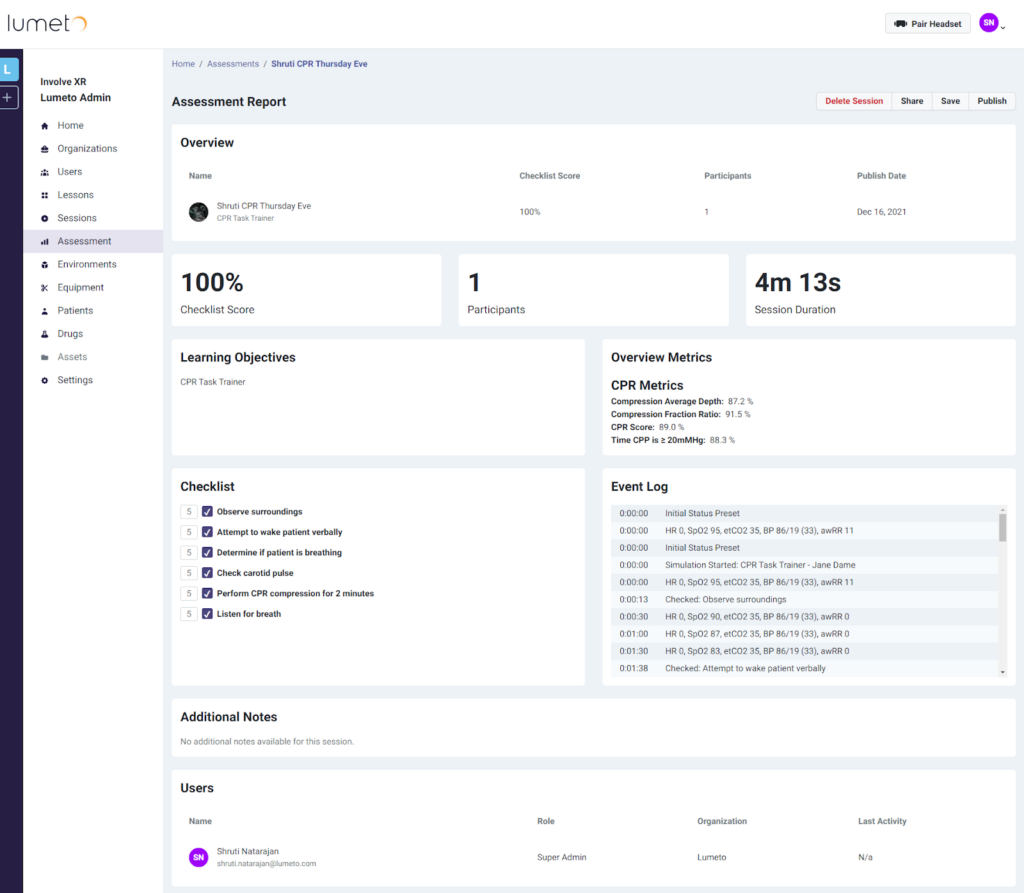
Generative AI
VR training programs are evolving with the addition of generative AI. It allows scenarios to adapt dynamically, creating unique challenges on the spot.
Lumeto’s AI-powered virtual patient is a prime example. This customizable conversational AI lets trainees interact with lifelike patients in VR.
The AI responds naturally to trainees’ actions and words just like a real patient would. It reacts both verbally and non verbally such as changes in facial expression or body language.
It enhances psychosocial and communication skills through realistic interactions, deepening immersion in the training experience. Trainers can create AI-driven patient profiles without pre-scripted dialogue.
In this video you can seeLumeto’s AI characters in action:
How to Choose the Right VR Training Program
Here’s how to find the right VR training solution for your institution:
Custom VR Training Programs
A VR training program might come with 10 or even 100 prebuilt scenarios. While these prebuilt scenarios are extremely valuable, customization is what sets a program apart. Customization allows you to design infinite training scenarios tailored to your requirements. This makes sure the program remains adaptable as your needs evolve over time.
For example, Lumeto offers over 500 easy customization tools. You can create fully customized virtual patients with unique:
- Medical history.
- Symptoms and conditions.
- Dialogues powered by generative AI.
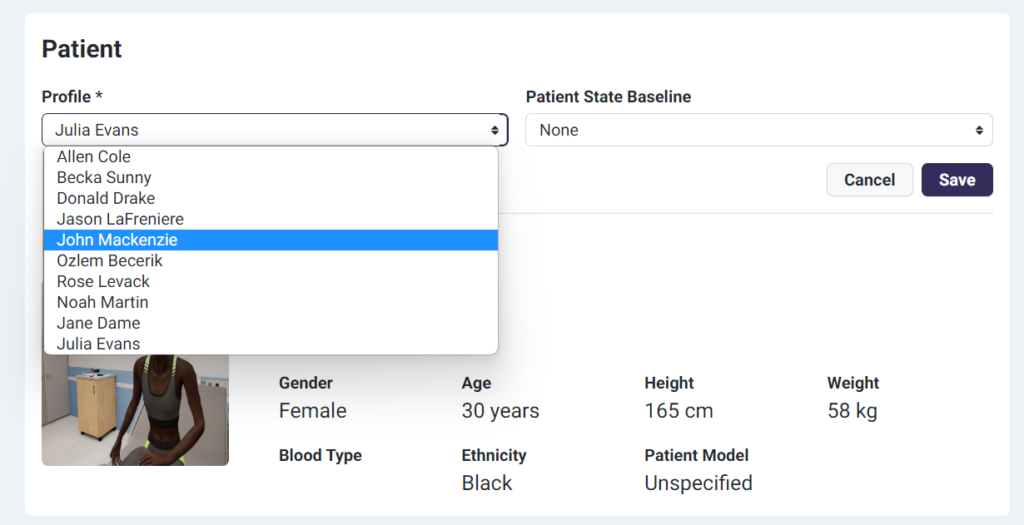
In addition, Lumeto lets you adjust other scenario variables like:
- Scenario environments.
- Medications.
- Patient labs and tests.
- Assessment criteria.
- Competency mapping and tracking.
Hardware Requirements
Modern VR training programs are designed to work without demanding heavy IT infrastructure or hardware specifications.
If a program requires high-end hardware, it’s likely to inflate your budget unnecessarily. A good VR solution should be both cost-effective and easy to deploy.
Lumeto’s VR training platform is a perfect example of minimal hardware requirements. It runs seamlessly on residential-grade WiFi with just a 5 Mbps download speed. Additionally, the software is compatible with devices powered by an Intel i5 processor or higher. The platform is easy to set up and requires an average IT setup time of just two hours per location. The system can also be used in small spaces.
Ease of Integration
Before integrating a VR training solution, ask yourself these questions:
- Where does it fit within your current training structure?
- What does it replace, if anything?
- And does implementing it require overhauling other systems or processes?
Trying to force a VR program into an already established workflow can make it difficult to prove ROI. Without thoughtful planning, it risks being seen as an expensive add-on rather than a valuable tool.
Lumeto makes curriculum integration seamless. Clinical specialists work closely with your trainers to align VR scenarios with specific training objectives. They also customize VR parameters to suit the program’s needs and guide trainers for practical implementation.
Learning Curve
Trainers already have a full plate, so adding a complex VR system can feel like one more thing to manage. That’s when stress kicks in, and sometimes, you’ll hear complaints about resources being stretched too thin.
Learners also have different comfort levels with tech; onboarding can become a headache for some. When that happens, training takes longer and feels less effective.
On Lumeto, trainers get interactive onboarding tools to simplify the process. AI takes over many repetitive tasks. That means trainers don’t have to babysit every session.
There’s a solid tutorial system for learners, and the platform’s optimized flow makes things intuitive. No fumbling around trying to figure out what to do. Just jump in, learn, and build skills.
Conclusion
VR training might seem like a leap, but it pays off in tangible ways. VR is faster, safer, and compliments your existing training workflow.
With Lumeto’s InvolveXR platform, you don’t have to overhaul your systems. Instead, you’ll improve them with minimal effort and maximum impact.
If you’re curious about how VR can drive innovation at your institution, book a demo with Lumeto today.
FAQs About VR Training Programs
How long does it take to implement a VR training program?
Implementation timelines with virtual reality training companies vary based on the program’s complexity. A prebuilt VR solution can be up and running within a few weeks.
How much does a VR training program typically cost?
The cost can range anywhere from $20,000 to $150,000+, depending on the number of licenses, support options, the type of hardware required, and the level of customization.
Can VR training programs be updated over time?
Yes, most VR training programs are designed to evolve. New modules may be added on request to meet changing organizational needs. Platforms with customization options make this process even easier.
Do we need IT experts to maintain the system?
Not necessarily. Modern VR training platforms are designed to be user-friendly and often come with customer support.